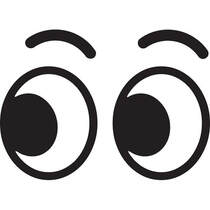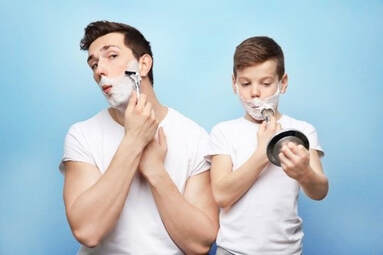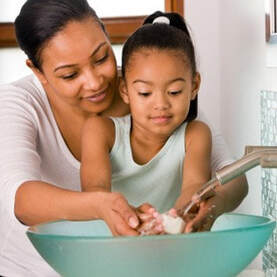“Child See, Child Do” – Behavioural Modelling and Observational Learning
by Kaelan Jones, Provisional Psychologist - BPsych (Hons) MProfPsyc
May 2019
by Kaelan Jones, Provisional Psychologist - BPsych (Hons) MProfPsyc
May 2019

Children watch others, and from watching others they learn what to do. Simply stating, “do as I say not as I do” will not stop your child from watching, learning, and modelling your behaviour, whether it be positive or negative. Whether your child is a toddler, tween or teenager; their behaviour will always be shaped by how you and those around them behave.
Behavioural Modelling and Observational learning
Psychologist, Albert Bandura, amongst other researchers established that as humans we are naturally inclined to engage in observation, and learn from others. An experiment commonly known as the “Bobo Doll Experiment,” showed that children aged 3-to-6 years of age treated an inflatable doll the same way that they observed adults doing so. For instance, children who observed an adult being aggressive towards the Bobo Doll became aggressive in their interactions with the Bobo Doll, whereas those who observed an adult being kind displayed kindness.
Now, take a moment to reflect on when you were younger…
Now, take a moment to reflect on when you were younger…
- How did you learn to tie your shoelaces?
- Did you ever use a swear word you shouldn’t have after hearing it used by adults around you?
- Did you ever pretend to apply makeup like mum, or shave your face like dad?
To have become the person you are today, you would have no doubt engaged in behavioural modelling and observational learning. Now that you are an adult, a parent, a carer; it is important to keep in mind that you now have younger people looking up to you and observing you closely to learn how to navigate the world.
What factors increase the likelihood that a child will observe and model a behaviour in the future?
- If a child sees a person being rewarded for their behaviour, then they are more likely to model that behaviour. Conversely, if they see someone being punished for their behaviour, then they will likely not imitate that behaviour.
- A child is likely to look up to, and imitate someone who is in an authoritative position (e.g. parent, teacher) and/or someone who is of a higher social status (e.g. peer, celebrity).
- A child is likely to closely observe and model those who are similar or like them (i.e. same age, sex, and interests).
- If a child lacks confidence or is unfamiliar with a situation, they are likely to observe others to understand what to do.
Modelling positive behaviours for my child – What do I need to do
Be sure to follow the rules that you set for your child. Children have difficulty understanding how a rule can be broken “sometimes” by an adult without the adult receiving punishment. Therefore, when we try to discipline the child for breaking a rule we have set, we are likely to get the response, “but how come you’re allowed and I’m not.”
Be cautious of modelling unhealthy behaviour. To get our children to develop healthy habits, we need to be cautious of the behaviours that we are engaging in around them.
Show them, don’t just tell them. Model the healthy behaviours rather than just telling them to do them. A child might not understand or know how to do what you are telling them to do. Also, children do not enjoy being lectured. Therefore, next time you are telling your child to do something, take a moment to show them what you would like them to do.
Be cautious of modelling unhealthy behaviour. To get our children to develop healthy habits, we need to be cautious of the behaviours that we are engaging in around them.
Show them, don’t just tell them. Model the healthy behaviours rather than just telling them to do them. A child might not understand or know how to do what you are telling them to do. Also, children do not enjoy being lectured. Therefore, next time you are telling your child to do something, take a moment to show them what you would like them to do.
But what if it is another person’s behaviour they are modelling?
If it is another person’s (e.g. a peer, another parent, a celebrity) behaviour they are modelling, you might be feeling a little bit stuck wondering what role you can play. It is not uncommon for adolescent aged children to turn to their peers and begin modelling their behaviours. So, what can you do when your child models the behaviour of others, and it is behaviour you don’t agree with?
You could try the following:
You could try the following:
- Continue to model behaviours you would like your child to display
- Reward positive behaviours
- Do not lecture them about what they are doing wrong, but make them aware of the consequences for negative behaviour choices.
- Do not be judgemental. Instead be curious and empathetic. That is, you could ask them why they are behaving in such a way.
- Be careful not to criticise the behaviour of the person they are modelling. For instance, if you criticise the behaviour of one of their closest friends, this could lead to them getting closer to their friend, and further from you.
The importance of observational learning and behavioural modelling in the context of mental health
It is important as the adults in our children’s lives that we try our best not to reflect own anxiety and low mood onto them. Whilst it can be hard to mask our Anxiety and Depression, there are some things we can try to prevent our children observing, and later modelling, our anxious and depressive behaviours.
Anxiety
- Try to model healthy ways of handling your anxiety – e.g. facing your fears, calming strategies and mindfulness practice.
- Do not reinforce fear through your body language or tone of voice – i.e. you do not want to have your body language or tone voice indicating to your child that a thing or situation is something to be afraid of, if it really isn’t.
- Try not to ask leading questions when they are in a situation that you might think is anxiety provoking. For example, a question such as “are you anxious?” could make them think there is something to be anxious about. If you think they might have some anxiety about something, ask them something more open like, “how are you feeling?”
- Do not avoid things that make you or your child anxious, as this teaches them that it is ok to avoid things that make them uncomfortable.
Depresssion
- Try to model healthy ways of handling your Depression – e.g. seeking support, engaging in physical activity, engaging socially.
- Do not avoid talking about or expressing your negative emotions (i.e. extreme sadness). Without acknowledging negative emotions and speaking about them openly, your child will think that it is normal to bottle up their negative emotions and hide them from others.
Sources
Bandura, A., Ross, D., & Ross, S. A. (1961). Transmission of aggression through imitation of aggressive models. Journal of Abnormal and Social Psychology, 63, 575-582. Retrieved from: https://pdfs.semanticscholar.org/3706/7acd33ad2ba2ed384baada06e7d74b800399.pdf
Cherry, K. (2019). How observational learning affects behaviour. Retrieved from: https://www.verywellmind.com/what-is-observational-learning-2795402
Goldstein, C. (2019). What to do (and not to do) when children are anxious. Retrieved from: https://childmind.org/article/what-to-do-and-not-do-when-children-are-anxious/
Health Direct. (2017). Kids and mental health. Retrieved from: https://www.healthdirect.gov.au/kids-mental-health
Mcleod, S. (2016). Bandura – Social Learning Theory. Retrieved from: https://www.simplypsychology.org/bandura.html
Morin, A. (2018). Role model the behaviour you want to see from your kids. Retrieved from: https://www.verywellfamily.com/role-model-the-behavior-you-want-to-see-from-your-kids-1094785
Raising Children Network:
https://raisingchildren.net.au/school-age/health-daily-care
https://raisingchildren.net.au/pre-teens/mental-health-physical-health
https://raisingchildren.net.au/teens/mental-health-physical-health
The Bobo Doll experiment video: https://www.youtube.com/watch?v=NjTxQy_U3ac
Bandura, A., Ross, D., & Ross, S. A. (1961). Transmission of aggression through imitation of aggressive models. Journal of Abnormal and Social Psychology, 63, 575-582. Retrieved from: https://pdfs.semanticscholar.org/3706/7acd33ad2ba2ed384baada06e7d74b800399.pdf
Cherry, K. (2019). How observational learning affects behaviour. Retrieved from: https://www.verywellmind.com/what-is-observational-learning-2795402
Goldstein, C. (2019). What to do (and not to do) when children are anxious. Retrieved from: https://childmind.org/article/what-to-do-and-not-do-when-children-are-anxious/
Health Direct. (2017). Kids and mental health. Retrieved from: https://www.healthdirect.gov.au/kids-mental-health
Mcleod, S. (2016). Bandura – Social Learning Theory. Retrieved from: https://www.simplypsychology.org/bandura.html
Morin, A. (2018). Role model the behaviour you want to see from your kids. Retrieved from: https://www.verywellfamily.com/role-model-the-behavior-you-want-to-see-from-your-kids-1094785
Raising Children Network:
https://raisingchildren.net.au/school-age/health-daily-care
https://raisingchildren.net.au/pre-teens/mental-health-physical-health
https://raisingchildren.net.au/teens/mental-health-physical-health
The Bobo Doll experiment video: https://www.youtube.com/watch?v=NjTxQy_U3ac


